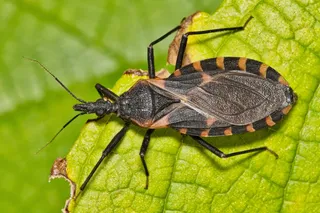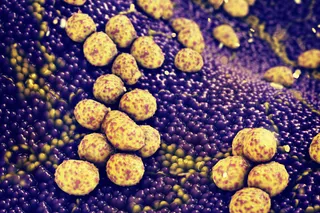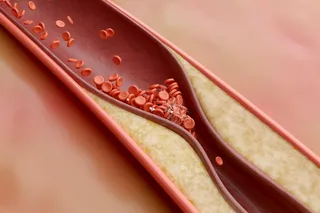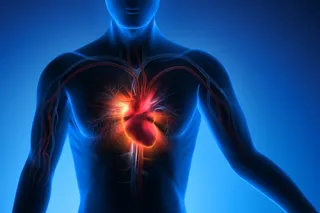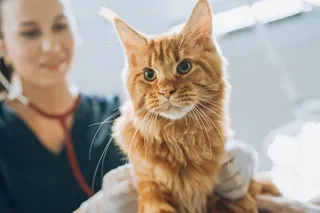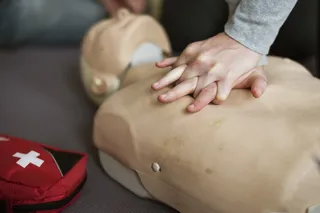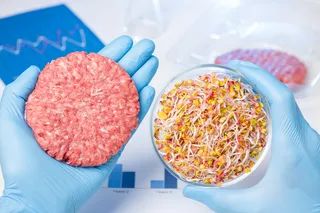As I thumbed through the first few inches of the more than foot- thick chart, it became apparent that this was a case in which things didn’t quite add up. The chart described the medical ordeal of a 35-year-old man, George Decker, a nonsmoker who had worked as a laborer in a local metal shop. He had been in perfect health until three months earlier, when he suddenly developed pneumonia in both lungs. Pneumonia can be defined as any inflammation of the lungs that causes white blood cells and cellular debris to collect in the air sacs, a condition that makes breathing difficult. In practice, most pneumonias are caused by some sort of microorganism. Yet in Mr. Decker’s case, repeated cultures of the sputum he coughed up--cultures examined for bacteria, fungi, or viruses--had all come back negative.
Other causes of inflammation had been ruled out as well: as far as Mr. Decker knew, he hadn’t inhaled any toxins or parasites or breathed any fluid into his lungs. His doctors eventually resorted to an open-lung biopsy to see if they could uncover the pathogen, but they found only tissue injury and repair. Over the next three months they watched helplessly as Mr. Decker’s lungs thickened, steadily undermining his ability to breathe. Eventually, after months of tests, of ventilator support, of failed treatments, and of desperate acts, he slipped away for reasons unknown.
Now it was my job to find out why. I’m a pathologist, one of the odd birds of medicine. Although we’re best known for performing autopsies (à la Quincy), we actually spend most of our time peering through microscopes at tiny snippets of tissue--called biopsies--in an attempt to understand a patient’s problem. Our role is that of final arbiter: to decide if a lump is benign or malignant, if a disease is a rare infection or a weird genetic disorder. This day my job was to piece together into a coherent diagnostic whole the story of this man’s demise.
I checked the toe tag, snapped a blade into a handle, and with strong strokes cut through the skin, down to bone. I made three such cuts: one from each shoulder diagonally to what is called the xiphoid process, a bit of cartilage found at the bottom of the breastbone, and a third from there down to the pubic bone. This opened up the whole torso. I peeled back the skin and removed first the ribs and then the lungs. As I held them cool in my hands, it was obvious that his had been a hopeless plight. The lungs, usually as light and airy as cotton candy, were as heavy and thick as liver.
After performing a gross visual examination of all the organs, I selected small pieces of each to be processed into slides. Days later, when I studied the sections of lung under the microscope, the reason for all that weight was clear. In healthy lungs good, oxygen-rich air is drawn down into tiny air sacs called alveoli. The alveoli in turn are wrapped in a meshwork of capillaries, so that only thin, delicate membranes separate the air from the blood; oxygen can easily and quickly get across. It is this oxygen, bound to the hemoglobin in red blood cells, that gives us the roses in our cheeks. In turn, carbon dioxide--a waste product of metabolism-- travels back across the same membranes and is exhaled. But in Mr. Decker’s lungs, these delicate membranes had become a dense, impenetrable thicket of debris--clot-forming proteins, inflammatory cells, and collagen--a cellular junkyard. The oxygen molecules would have had no chance to traverse this barrier and reach the blood flowing past in the capillaries. Thus, although he could draw air into his lungs, the oxygen could not get to the blood. Nor could the carbon dioxide make its way to the lungs to be exhaled. Mr. Decker had suffocated.
Still, the reason this junk had collected in his lungs remained unknown. My stains for bacteria, fungi, viruses, and parasites were all negative. There were, in the tissues I examined, no telltale signs to explain why all this had happened.
Stumped, I returned to the chart. There, in notes made by a third-year medical student on the day Mr. Decker first showed up at the hospital, was my first clue. This bilingual student reported on a conversation he’d had with Mr. Decker’s Spanish-speaking girlfriend, who told him that on July 3, Mr. Decker had just finished cooking when he began wheezing, coughing, and gasping for air. She’d accompanied him to the hospital, but he wasn’t happy about being there. Indeed, he’d taken a swing at the nurses even though he was still breathless. The doctors treated him for an upper respiratory infection, and then, against their advice, he left. The next day he returned to the hospital, his skin tinged blue from lack of oxygen. By itself, the blue coloration didn’t mean much; any bad pneumonia, any severe lung infection, any major injury to lung tissue can result in the same discoloration. But that it had happened so quickly struck me as somehow important.
I needed to ask some questions. Mr. Decker’s girlfriend, it turned out, was nowhere to be found. But at the top of the admission sheet, on the first page of the chart, was the name of his employer--a Mr. Wilson. I called Mr. Wilson, identifying myself as the medical examiner investigating the death of George Decker. After a long pause, he quietly agreed to answer my questions.
I began by asking exactly what it was that Mr. Decker had done in the metal shop. Mr. Wilson told me that he poured aluminum ingots. Then I simply asked, What kind of guy was Mr. Decker?
Oh, he was a fellow on his way to mucho dinero, came the reply.
I was intrigued. Well, how did he get mucho dinero? I asked.
Any way he could.
I paused a moment, then plunged right in. The ways Mr. Decker used--were they on the up-and-up?
You could say no, he replied carefully.
As I listened to Mr. Wilson, my intuition took over. I had a strong hunch about what might be going on here, but I needed more information. I remembered that Mr. Decker’s girlfriend said he’d been cooking just before he got sick. I asked Mr. Wilson, Do you know what he was cooking?
No, not exactly, came yet another careful answer. I decided to backtrack.
Well then, do you know how he got his money, besides by pouring aluminum ingots?
He paused, took a deep breath, and to my surprise decided to answer me. George collected old fillings from dentists’ offices and extracted the gold and silver.
What did he do with the metal? I continued probing.
Cagily, Mr. Wilson replied that he didn’t know, but he volunteered the seemingly unconnected information that in the past year alone Mr. Decker and his girlfriend had made three trips to Colombia.
I closed with one final question: Did Mr. Decker use drugs?
Again he paused, inhaled, and replied, I personally never saw Decker use drugs.
Thank you, I said, before hanging up. That had been an overly specific denial if ever I’d heard one. The man was a regular Henry Kissinger. It was all the confirmation I needed.
The story was beginning to unfold. The way I saw it, Mr. Decker was acquiring dental fillings, extracting the gold and silver using his vocational skills from the metal shop, and traveling to Colombia to buy drugs. But how was this connected to the pneumonia and his death?
A call to my dentist and later to a dental laboratory gave me the information I needed. They explained to me that gold fillings are actually an alloy of gold, palladium, and other metals, and that silver fillings are essentially an amalgam of silver and mercury, though tin, zinc, and copper can also be added.
Gold is a heavy, impervious metal that in a pure state is soft-- far too soft to withstand the gnashing of teeth. To serve as a tooth replacement, the gold is mixed with palladium; the final alloy is both tough and resistant to the acidic environment found in the mouth. The alloy is made by heating the metals in their proper proportions and then letting them cool; reheating will separate them. Gold melts at 1945 degrees, which is much lower than the melting point of palladium. So as the fillings are heated, the gold melts first and can be poured off, leaving the other metals behind.
Mr. Decker would have been fine if he had confined himself to gold fillings. But he got greedy and also went after the silver fillings, which are much more abundant. His chief job here was to separate silver from mercury. Mercury--nicknamed quicksilver--is a liquid at room temperature. When combined with other metals and cooled it stays solid, but it becomes a gas at the fairly low temperature of 674 degrees. To get the silver out of the fillings, then, Mr. Decker must have heated them until the mercury boiled off, leaving behind the silver.
In its liquid form, mercury is surprisingly nontoxic--people have ingested ounces with little effect--because it has such a high surface tension that it balls up easily, leaving very little surface area available to interact with the body. But when heated, mercury becomes an invisible, odorless toxic gas. Vaporized mercury atoms can be inhaled deep into the lungs, where they diffuse across the delicate membranes and enter the red blood cells.
Red cells contain oxidative enzymes that catalyze the linking of oxygen to hemoglobin. But when mercury gets into the bloodstream, these same enzymes oxidize it instead, yielding a highly reactive ion that destroys anything with which it comes in contact. As a consequence, mercury becomes a molecular hand grenade in which the pin has ironically been pulled by the blood itself. And as the mercury ions run rampant through the lung tissue--as they can through other tissues, including those of the brain, which would explain Mr. Decker’s combativeness--they do more than just destroy it: they incite a riot of inflammation as the body desperately attempts to repair the cellular chaos. If enough mercury has been sucked into the lungs, the tissue damage and inflammation result in irreversible pneumonia and death.
And that is what I hypothesized had happened to George Decker. What I needed to do now was confirm the cause and mechanism of his death. I sent off small scraps of the lung tissue to the laboratory, which reported that though months had passed, traces of mercury were still present. So it was definitely mercury poisoning. To be sure about how the poisoning had occurred, I called the Occupational Safety and Health Administration and asked agents to test Mr. Decker’s home for heavy metals. The next week they reported that beneath the floorboards adjacent to the stove they had found mercury at more than 1,000 times permissible levels. The day he got sick-- July 3--George Decker had been cooking teeth in his kitchen.
When I filled out the final autopsy report, I listed Mr. Decker’s cause of death as irreversible diffuse alveolar damage as a consequence of heavy metal intoxication, a long-winded way of saying his lungs failed. But as the surgeon Richard Selzer once wrote, autopsies give us the facts but not the truth. George Decker had indeed died of lung failure, but I wonder if the cause of his death wasn’t far less exotic. It seems to me that he died from a combination of two of the oldest and most insidious killers of all: ignorance and avarice.




